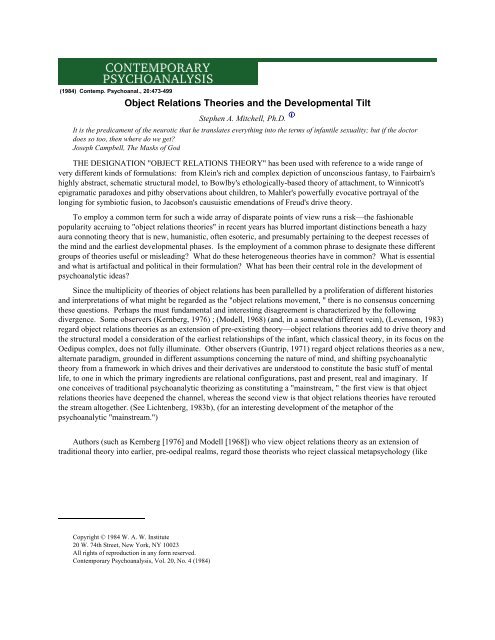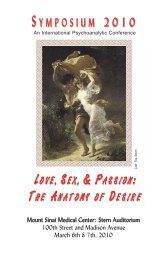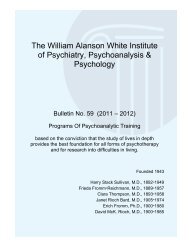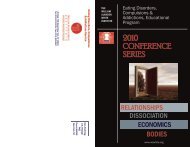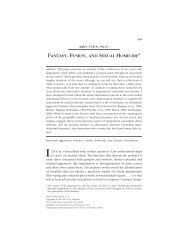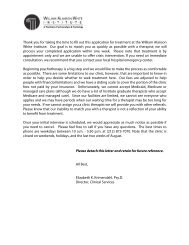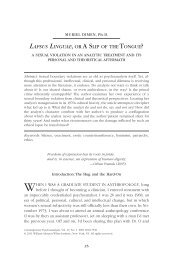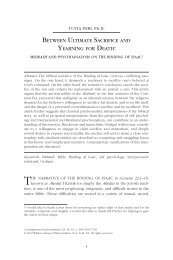Object Relations Theories - the William Alanson White Institute
Object Relations Theories - the William Alanson White Institute
Object Relations Theories - the William Alanson White Institute
Create successful ePaper yourself
Turn your PDF publications into a flip-book with our unique Google optimized e-Paper software.
interpersonal environment), relations which are relatively independent of <strong>the</strong> drives. O<strong>the</strong>r <strong>the</strong>orists havetransformed <strong>the</strong> concept "id" so that <strong>the</strong> repository of <strong>the</strong> drives <strong>the</strong>mselves is subject to <strong>the</strong> impact of early objectrelations (Jacobson), or actually comprised of relational configurations (Kernberg, 1976). Ano<strong>the</strong>r device has been<strong>the</strong> strategic use of diagnosis (Kernberg, 1976) ; (Kohut, 1971) ; (Stolorow and Lachmann, 1980) —classical <strong>the</strong>oryand <strong>the</strong> structural conflict it depicts is correct for neurosis; however, for more severe disorders (borderlines,narcissistic personality disorders, developmental arrests, etc.), a new model focused on object relations is required.(See Greenberg & Mitchell [1983] for an extended discussion of <strong>the</strong>se various strategies.) One of <strong>the</strong> mostimportant devices through which accommodation has been accomplished, leading to pervasive implications in <strong>the</strong>way object relations concepts have been shaped, has been <strong>the</strong> "developmental tilt"—i.e., Freud was correct inunderstanding <strong>the</strong> mind in terms of conflicts among drives; object relations are also important, but earlier.For many strategists of accommodation <strong>the</strong> pillar of classical metapsychology, <strong>the</strong> structural model, isunderstood to provide an adequate framework for an account of human experience, both normal and pathological,and that account depicts <strong>the</strong> conflict among various drive derivatives, and between drive derivatives and <strong>the</strong>defensive functions of <strong>the</strong> ego and <strong>the</strong> superego. When a <strong>the</strong>orist following this strategy wants to introduce variousrelational needs and processes as primary in <strong>the</strong>ir own right, as irreducible, as nei<strong>the</strong>r merely gratifiers nor defendersagainst drives, <strong>the</strong>y are often introduced as operative before <strong>the</strong> tripartite structures of id, ego and superego havebecome separated and articulated. Theorists concerned with linear continuity necessarily preserve <strong>the</strong> classical <strong>the</strong>oryof neurosis as centered around sexual and aggressive conflicts at <strong>the</strong> oedipal phase. They set object relationsformulations into pre-existing <strong>the</strong>ory by arguing that <strong>the</strong>y pertain to a developmental epoch prior to <strong>the</strong> differentiationof psychic structures, in <strong>the</strong> earliest relationship of <strong>the</strong> mo<strong>the</strong>r and infant. The traditional model is jacked up, and newrelational concepts are slid in underneath. To return to our architectural metaphor, it is as if a new, complex androomy foundation level has been set beneath an older edifice; <strong>the</strong> upper stories remain just as <strong>the</strong>y were, but <strong>the</strong>center of gravity has shifted downward. The original structure is intact, but unoccupied; <strong>the</strong> scene of <strong>the</strong> action hasmoved downward to <strong>the</strong> lower levels.The Developmental Tilt and Its DistortionsMelanie Klein evolved an elaborate account of human experience as a passionate struggle betweenmurderousness, malevolence and envy towards significant o<strong>the</strong>rs, and a deep sense of love, gratitude and a wish tosave and restore <strong>the</strong>m. Michael Balint depicts human relations as a search for a perfect "unconditional" love,offering <strong>the</strong> possibility of a passive surrender to a trusted and caring nurturance. D. W. Winnicott came to seepsychopathology as centering on a struggle between an au<strong>the</strong>ntic and spontaneous expression of impulses andwishes and a need to shape oneself around <strong>the</strong> way o<strong>the</strong>rs see one, according to <strong>the</strong> image o<strong>the</strong>rs provide and seemto require. Margaret Mahler locates <strong>the</strong> experience of self in a pervasive dialectic between a need for autonomy andself-definition and a desperate longing to surrender to and fuse with ano<strong>the</strong>r. Heinz Kohut characterizes <strong>the</strong> self asa bi-polar structure generated from <strong>the</strong> tension between a need for a warm and embracing recognition, and a need toidentify with admired o<strong>the</strong>rs.Each of <strong>the</strong>se contributions (presented here in obviously greatly collapsed, over simplified and schematic form)constitutes an object relations <strong>the</strong>ory generally applicable to human experience at all points within <strong>the</strong> life cycle.Each offers an account of life's central passions, an account which is at considerable variance from that provided byclassical metapsychology, in which human experience is portrayed as a struggle to negotiate between <strong>the</strong> claims ofbody-based, asocial psychic tensions and <strong>the</strong> demands of social reality. In each object relations account, <strong>the</strong> humanorganism is seen as inherently social, embedded in a matrix of relationships, seeking relatedness with
The developmental tilt has generated what at times seems to be an infinite regress in claims to developmentalpriority. A psychodynamic account which <strong>the</strong> author regards as more basic, more primary than structural conflict, ispresented as earlier, leading to <strong>the</strong> attribution of extra-ordinarily complex affective and cognitive capacities to <strong>the</strong>newborn (Klein), great weight granted to prenatal and birth experiences (Winnicott, 1949), and even speculationson <strong>the</strong> effects on <strong>the</strong> embryo, in its first days, of parental attitudes at <strong>the</strong> point of conception (Laing, 1976). Deeperis transformed into earlier, ra<strong>the</strong>r than more fundamental, as if dynamics attributable to <strong>the</strong> first months of life oreven to prenatal existence still occupy <strong>the</strong> most basic layers of experience, underlying and governing psychic eventsand processes of later chronological origin. Thus, <strong>the</strong>orists attempting to accomodate <strong>the</strong> drive model to objectrelations issues attempt to keep instinctual and relational issues temporally separable. By pushing relational issuesinto an earlier developmental era, <strong>the</strong>y preserve <strong>the</strong> oedipus complex as still fundamentally instinctual. This modeof introducing <strong>the</strong>oretical innovation strains credulity; it also skews <strong>the</strong>se innovations in a peculiar way, bycollapsing relational issues into <strong>the</strong> interaction between <strong>the</strong> mo<strong>the</strong>r and infant during <strong>the</strong> earliest months of life.Let us consider as a representative example an excerpt from <strong>the</strong> work of Balint (1968), who introduced rich andclinically useful object relations concepts while remaining loyal, in basic respects, to drive <strong>the</strong>ory. Balint developed<strong>the</strong> concepts of "primary love" and <strong>the</strong> "basic fault" in an innovative and clinically useful effort to account fortransference/countertransference impasses with certain kinds of difficult patients. The principle of abstinence centralto classical technique, Balint points out, was developed in <strong>the</strong> context of drive <strong>the</strong>ory. The patient's impulses andwishes must not be gratified, lest <strong>the</strong>y become fur<strong>the</strong>r entrenched ra<strong>the</strong>r than transformed into memory and renounced.However, certain patients, Balint argues, become stuck in analysis, demanding a responsiveness from <strong>the</strong> analyst,without which <strong>the</strong>y seem unable to progress. Balint characterizes <strong>the</strong>se longings and <strong>the</strong> patient's efforts to gratify<strong>the</strong>m as a need for "primary love."In my view, all <strong>the</strong>se processes happen within a very primitive and peculiar object-relationship, fundamentallydifferent from those commonly observed between adults. It is definitely a two-person relationship in which, however,only one of <strong>the</strong> partners matters; his wishes and needs are <strong>the</strong> only ones that count and must be attended to; <strong>the</strong> o<strong>the</strong>rpartner, though felt to be immensely powerful, matters only in so far as he is willing to gratify <strong>the</strong> first partner's needsand desires or decides to frustrate <strong>the</strong>m; beyond this his personal interests, needs, desires, wishes, etc., simply do notexist. (1968, p. 23)Balint has provided an account of <strong>the</strong> analytic encounter which is based on relational concepts and is alternativeto that generated by <strong>the</strong> drive model. It is not gratification of specific impulses that <strong>the</strong> patient is seeking, Balintargues, but <strong>the</strong> need to establish a certain kind of relationship—a state of unconditional love. What is puzzlingabout Balint's description is his restriction of such longings to <strong>the</strong> earliest and most "primitive" object relationships.It appears that Balint's depiction of <strong>the</strong> longing for primary love has wide applicability. Surely, we might define"mature" love as a relationship characterized by mutuality—"When <strong>the</strong> satisfaction or <strong>the</strong> security of ano<strong>the</strong>r personbecomes as significant to one as is one's own satisfaction or security, <strong>the</strong>n <strong>the</strong> state of love exists" (Sullivan, 1940,pp. 42–43). Such mutuality, however, seems clearly an ideal, not a normative practice. No matter how mature andhealthy, all love relationships are characterized by periodic retreats from mutuality to self-absorption and demandsfor unconditional sensitivity and acceptance. Many patients (not at all as "regressed" as those Balint sees assuffering from a "basic fault") take many years before <strong>the</strong>ir relationships are weighted more in <strong>the</strong> direction ofmutuality than self-absorption. Sullivan argued that most of us are chronically juvenile, integrating relationships on<strong>the</strong> basis of our own ego-centric concerns, lacking <strong>the</strong> capacity for intimacy, for seeing things from <strong>the</strong> o<strong>the</strong>r'sperspective as well. Fur<strong>the</strong>r, it seems particularly odd to depict <strong>the</strong> emergence in <strong>the</strong> analytic situation of apreoccupation by <strong>the</strong> patient with his or her own needs and an experience of <strong>the</strong> analyst as existing only in relationto those needs as "primitive." Although such longings and demands are organized and expressed differently indifferent developmental eras and in different types of patients, <strong>the</strong>y are almost inevitable. One might argue that <strong>the</strong>
It took us about two years before <strong>the</strong>se connections made sense to her. At about this time, she was given <strong>the</strong>interpretation that apparently <strong>the</strong> most important thing for her was to keep her head safely up, with both feet firmlyplanted on <strong>the</strong> ground. In response, she mentioned that ever since her earliest childhood she could never do asomersault; although at various periods she tried desperately to do one. I <strong>the</strong>n said: "What about itnow?"—whereupon she got up from <strong>the</strong> couch and, to her great amazement, did a perfect somersault without anydifficulty. (pp. 128–29)This interaction proved to be an important breakthrough in <strong>the</strong> treatment; "many changes followed in heremotional, social, and professional life, all towards greater freedom and elasticity."How does Balint understand <strong>the</strong> somersault, <strong>the</strong> "crucial event" in this case? He characterizes it as a"regression, " which he carefully defines as <strong>the</strong> "emergence of a primitive childish form of behavior after moremature, more adult, forms have firmly established <strong>the</strong>mselves" (p. 129). This is a peculiar and unpersuasivecharacterization. Why is turning a somersault "childish" and "primitive"? Against what faded and anemic vision ofadulthood is this being measured? Here is a young woman who lives an adulthood of great caution, constriction anduninvolvement. Given <strong>the</strong> interpretive context Balint and <strong>the</strong> patient had developed, and given <strong>the</strong> patient'ssubsequent progress, <strong>the</strong> somersault seems clearly a metaphorical enactment of her new willingness to take risks, toplunge herself into things without knowing exactly how <strong>the</strong>y will turn out, to act in ways o<strong>the</strong>r than a cautiousplacing her feet slowly one in front of <strong>the</strong> o<strong>the</strong>r. Why "childish" and "primitive" <strong>the</strong>n? The meaning of <strong>the</strong> act isclearly a progression, not a regression, an expansion of <strong>the</strong> patient's maturity and potentials, not a diminution of<strong>the</strong>m. Is <strong>the</strong> behavior itself so "childish" and "primitive"? Adults are not supposed to make spontaneous physicalgestures, to play in this way?The most striking feature of Balint's account of this intriguing clinical moment, however, is what is omitted inhis characterization of it as an "emergence." According to Balint's account, this act didn't simply emerge—it wasinvited! It was Balint, <strong>the</strong> adult analyst, who suggested that <strong>the</strong> patient try a somersault; what was new for <strong>the</strong>patient was her ability to respond to this invitation. The patient was closely tied to her obsessional but reliablefa<strong>the</strong>r. Her analyst of several years, doubtlessly also obsessional and reliable, acts in a very different fashion from<strong>the</strong> cautious fa<strong>the</strong>r—he invited her to play, to take a risk, and in so doing takes a risk himself. He seduces her,in a fashion; or, perhaps, allows himself to respond to her hobbled seductiveness. Here is a man, despite hisrespectability, who is not bound by convention, willing to try something very different, whose outcome is unknownand unknowable. Should we characterize <strong>the</strong> analyst's invitation as regressive? This seems an extraordinarilymisleading way to depict a brilliant and creative piece of clinical work. The patient and analyst have recreated in<strong>the</strong> transference a powerful attachment mediated through reliability and cautiousness, in which <strong>the</strong> decorum andprofessionalism of <strong>the</strong> analytic situation are symbolic equivalents of <strong>the</strong> parents' timidity and deep fear of life andspontaneity. Perhaps <strong>the</strong> crucial event wasn't <strong>the</strong> patient's somersault at all, but <strong>the</strong> analyst's invitation, throughwhich he stepped out of <strong>the</strong> transferential integration in which he was participating and <strong>the</strong>reby transformed <strong>the</strong>relationship. Thus, Balint's clinical data suggest that <strong>the</strong> patient's psychopathology is strongly bound up with herattachment to her parents and <strong>the</strong>ir character pathology. The clarification of that attachment, and <strong>the</strong> mutualdevelopment of new forms of relation with respect to <strong>the</strong> analyst, are ameliorative. These new forms of relationreflect a playfulness, spontaneity, a willingness to take risks. The bias generated by <strong>the</strong> developmental tilt leadsto a characterization of <strong>the</strong>se events as <strong>the</strong> emergence, even if benignly, of a childishness, which, it seems to me,strikingly distorts its likely meaning.The developmental tilt is evident not just in <strong>the</strong> writings of authors from <strong>the</strong> British School, but also in <strong>the</strong> workof <strong>the</strong>orists in <strong>the</strong> tradition of American Ego Psychology. Here structural conflict over sexual and aggressiveimpulses is seen as dominating later childhood and subsequent development. When relational issues are added to<strong>the</strong> <strong>the</strong>ory, most importantly in <strong>the</strong> contributions of Mahler, Jacobson and Kernberg, <strong>the</strong>y are introduced aspertaining to <strong>the</strong> earliest developmental phase; <strong>the</strong>ir evidence later in life is regarded as a regressive residue of veryearly disturbance. Consider this clinical excerpt from Blanck and Blanck (1974), who have syn<strong>the</strong>sized various egopsychological contributions and applied <strong>the</strong>m to clinical practice.
The dramatic conflict-ridden Oedipus of classical analysis, with its percepts of a child whose aspirations arecrumbling under <strong>the</strong> impact of castration fear, is not a primary maturational necessity, but only <strong>the</strong> frequent result offrequently occuring failures from <strong>the</strong> side of narcissistically disturbed parents … (p. 247)Similarly, suggests Kohut, if <strong>the</strong> analyst does not subject <strong>the</strong> patient to "empathic failures, " <strong>the</strong> analysisproceeds smoothly and non-conflictually.To regard conflict as <strong>the</strong> exclusive property of drive <strong>the</strong>ory and to present relational concepts as fundamentallynon-conflictual in nature is to seriously limit <strong>the</strong> clinical utility of object relations contributions. It misses <strong>the</strong>importance of conflicts between and among different relationships and identifications, where ties and loyalties toone parent, for example, are experienced as (and in reality may very well be) a threat to ties and loyalties to <strong>the</strong>o<strong>the</strong>r. Also missed is <strong>the</strong> clinical importance of conflict within a single relationship. Intimacy is never a primrosepath, but a process which includes risks, choices and anxiety. Particularly for patients whose past efforts atrelatedness have been severely dashed, warmth, nurturance, connection, can be a frightening prospect. OttoWill (1959) notes that for some patients, paradoxically, "closeness to ano<strong>the</strong>r implies anxiety, separation anddeath" (p. 213).Surely, a patient's retreat, fragmentation and withdrawal may be caused by a missed connection on <strong>the</strong> part of<strong>the</strong> analyst, but not necessarily so. To assume that it is, unnecessarily limits clinical options. It is often not <strong>the</strong>experience of "empathic failure, " but <strong>the</strong> experience of empathic success that precipitates withdrawal, devaluationand fragmentation. For someone who has experienced repeated failure of meaningful connection, whose essentialattachments are to constricted and painful relationships, ei<strong>the</strong>r in actuality or fantasy, hope is a very dangerousfeeling. It may be precisely <strong>the</strong> sense of meaningful connection that precipitates <strong>the</strong> patient's withdrawal, because<strong>the</strong> possibility of such connection calls into question <strong>the</strong> basic premises of <strong>the</strong> patient's painfully constrictedsubjective world. Sullivan's (1953) formulation of <strong>the</strong> "malevolent transformation, " Klein's (1951) concept ofenvious spoiling, and Bion's (1967) depiction of "attacks on linking" all point to <strong>the</strong> dangers of hope and <strong>the</strong>conflictual nature of relational needs. The minimization of <strong>the</strong> importance of conflict, which sometimesaccompanies object relations concepts introduced through <strong>the</strong> developmental tilt, leads to a view of relationalprocesses which is simplistic and overlooks <strong>the</strong>ir essential ambivalence in <strong>the</strong> psychoanalytic situation.A closely related clinical emphasis sometimes generated by <strong>the</strong> developmental tilt is <strong>the</strong> tendency to portray <strong>the</strong>patient as passive, detached and victimized. Psychopathology is a direct product of deprivation, "environmentalfailure." Certain kinds of interpersonal experiences are necessary for <strong>the</strong> growth of <strong>the</strong> self; when <strong>the</strong>se are lacking,central features of <strong>the</strong> child remain buried, unevoked, frozen. The patient as he presents himself for treatment is anempty shell vacated by this missing core, which can only be brought to life through <strong>the</strong> analyst's creation of a morereceptive environment; <strong>the</strong> passive, "true self" of <strong>the</strong> patient awaits this call. Guntrip (1971) states most clearly <strong>the</strong>premises of this approach to treatment, which I have characterized as <strong>the</strong> "Sleeping Beauty" model (Greenberg &Mitchell, 1983). Psycho<strong>the</strong>rapy is<strong>the</strong> provision of <strong>the</strong> possibility of a genuine, reliable, understanding, and respecting, caring personal relationship inwhich a human being whose true self has been crushed by <strong>the</strong> manipulative technique of those who wanted to make him"not be a nuisance" to <strong>the</strong>m, can begin at last to feel his own true feelings, and think his own spontaneous thoughts, andfind himself to be real. (p. 182)Guntrip sees <strong>the</strong> neurotic as a "neglected physically grown-up child" having been deprived of <strong>the</strong> "elementaryright to <strong>the</strong> primary supportive relationship that can alone enable him to live" (1971, p. 156). Thus, <strong>the</strong> analystbrings to <strong>the</strong> frightened child in <strong>the</strong> patient missed possibilities for life. "At <strong>the</strong> deepest level, psycho<strong>the</strong>rapy isreplacement <strong>the</strong>rapy, providing for <strong>the</strong> patient what <strong>the</strong> mo<strong>the</strong>r failed to provide at <strong>the</strong> beginning of life" (1971, p.191).This view of <strong>the</strong> patient as an abandoned, deprived, detached infant overlooks <strong>the</strong> extent to which
psychopathology often entails an active clinging to, often an insistence on, symptomatic behaviors and painfulexperience. Fairbairn's notion that underneath all forms of psychopathology one finds an attachment to "badobjects" points to this active dimension which Guntrip's later formulations (when he was under <strong>the</strong> influence ofWinnicott's work) lose. Psychopathology is not simply an absence or fearful avoidance of good relatedness. Weoften observe not just an avoidance of <strong>the</strong> positive, but a fascination with <strong>the</strong> negative. Patients with repetitivedisturbances in relations with o<strong>the</strong>rs are drawn, like <strong>the</strong> moth to <strong>the</strong> flame, to specific negative types ofrelations—sadistic, skittish, withdrawn, or debilitated. This compulsive repetition of painful early experience seemsto reflect not just a detachment from some forms of relationship, but an attachment to o<strong>the</strong>rs. The masochisticcharacter seeks abuse partially because <strong>the</strong> violence imparts a fantasy of connection and caring from o<strong>the</strong>rs who areexperienced as inaccessible in o<strong>the</strong>r ways. The depressed character seeks deprivation often because it makespossible a deep and often fantasied sense of connection with a schizoid or depressed parent, so unavailable in o<strong>the</strong>rways. What <strong>the</strong> patient is attached to is often not actual attributes of <strong>the</strong> parents, but fantasied attributes, notsatisfying features of <strong>the</strong>ir relationship, but precisely what is missing. It is <strong>the</strong> deprivation, <strong>the</strong> pain, <strong>the</strong> depressionwhich serves as a vehicle for attachment. Embedded in much psychopathological experience and behavior arepersonifications of o<strong>the</strong>rs, to whom <strong>the</strong> analysand feels tied through <strong>the</strong> pathology. The patient does not simplymiss or exclude from consciousness signals which would lead to nurturance and attachment—he looks for differentcues, which draw him into attachments not based on caring and support but on pain, misery and so on. The dangerof <strong>the</strong> new dimension of <strong>the</strong> analytic relationship is that it challenges <strong>the</strong>se allegiances; <strong>the</strong> patient must choosebetween attachments to fantasied images and presences which impart an often subtle sense of safety and connection,and <strong>the</strong> possibility of attachment to real o<strong>the</strong>rs, with all <strong>the</strong> attendent risks. Thus, analysands often speak of <strong>the</strong> dreadof a profound isolation in giving up <strong>the</strong>ir neurosis; psychopathology is not merely a state of aborted, frozendevelopment, but a cocoon actively woven out of fantasied ties to significant o<strong>the</strong>rs. Consider <strong>the</strong> dream of ananalysand in <strong>the</strong> termination phase of treatment.The patient's parents suffered from deep depressions and considerable misfortune, that peaked when he was six,leading <strong>the</strong>m to withdraw into <strong>the</strong>ir own isolation and depression in a very global sort of way. He developed into anextremely competent and resourceful man, who suffered from a very low sense of self-esteem, bouts of depression, anda tendency to form symbiotic relations with lovers who were greatly disadvantaged in some fashion. The dreamfollowed a period of work in which he had begun to experience himself and his relationships with o<strong>the</strong>r people in amore positive, even joyful way. This movement made him anxious; he feared that it was his depression and sensitivityto depression in o<strong>the</strong>rs that made him a desirable person. Here is <strong>the</strong> dream:I am on a small island off <strong>the</strong> mainland with my parents and sister. I take a boat to <strong>the</strong> mainland, where <strong>the</strong>re is a sortof carnival going on. I walk around, watching <strong>the</strong> people, participating, having a great time. Then I remember that Imust return to <strong>the</strong> island. I get in <strong>the</strong> boat and try to go back, but insects come and sting me. If I move back and stoprowing, <strong>the</strong>y stop. I start to move toward <strong>the</strong> island and <strong>the</strong>y sting again. I stop; <strong>the</strong>y stop. I am very conflicted aboutwhat to do. After a long time of trying and stopping, I give up with a sense of relief, and rejoin <strong>the</strong> activities on <strong>the</strong>mainland.The dream seemed to fit his experience at that time. He felt a sense of <strong>the</strong> rich possibilities which life and o<strong>the</strong>rpeople offer. Yet he also felt bound by his loyalties to his family and <strong>the</strong>ir ways. The connection to <strong>the</strong>m wasmaintained through a stinging pain. As long as he suffered like <strong>the</strong>y had, remaining isolated from o<strong>the</strong>rs, he wasbound up with <strong>the</strong>m. To live more fully is to abandon <strong>the</strong>m and <strong>the</strong> comfort which <strong>the</strong> tie to <strong>the</strong>m provides.Paradoxically, <strong>the</strong> deadness of his early experience with his parents, recreated in his current life, provided him alargely fantasied connection with o<strong>the</strong>rs, which he felt kept him alive and encased in an illusory safety.Beneath a seemingly passive "detachment" is often a secret attachment, largely unconscious, but experienced asnecessary and life-sustaining. The relational issues depicted in <strong>the</strong> contributions of object relations authors greatlyilluminate patients' struggles, both past and present, yet <strong>the</strong> tendency to collapse <strong>the</strong>se issues into early infancy andto portray <strong>the</strong> patient as nonconflictually and passivelyawaiting a reawakening distorts <strong>the</strong>ir nature and <strong>the</strong> processesthrough which <strong>the</strong>y are perpetuated.
<strong>Object</strong> <strong>Relations</strong> Theory: Divergent Clinical ApplicationsAll relational model <strong>the</strong>ories rest, ei<strong>the</strong>r explicitly or implicitly, on a broad developmental perspective. Humanrelations are understood to constitute <strong>the</strong> basic stuff of experience, and <strong>the</strong> pursuit and maintenance of relatedness isseen as <strong>the</strong> essential motivational thrust both in normality and in psychopathology. <strong>Relations</strong> take different formsacross <strong>the</strong> life cycle—early relationships between <strong>the</strong> infant and caretakers are precursors and, in some sense,prerequisites to later, more complex relationships. A commonly held tenet of all versions of relational model<strong>the</strong>ories is <strong>the</strong> premise that disturbances in <strong>the</strong> earliest relationship with caretakers significantly interferes withsubsequent relateness, and is a predisposing factor in <strong>the</strong> generation of later psychopathology.With respect to clinical applications, however, object relations <strong>the</strong>ories often diverge not around <strong>the</strong> question ofwhat <strong>the</strong> patient's problem was (i.e. what went wrong in his or her early relationships), but around <strong>the</strong> question ofwhat <strong>the</strong> problem now is, and what is best done about it. The patient's development and capacity for relatedness hasbeen warped by early difficulties in relations with significant o<strong>the</strong>rs. Agreed. The question is, what is <strong>the</strong> presentnature of <strong>the</strong>se difficulties, and what is <strong>the</strong> most effective point of remediation. Authors whose vision passesthrough a lens of <strong>the</strong>ory skewed by <strong>the</strong> developmental tilt tend to view <strong>the</strong> patient as an infantile self in an adultbody, fixed in developmental time and awaiting interpersonal conditions which will make fur<strong>the</strong>r developmentpossible. In this view, what was missed is still missing, and needs to be provided for essentially in <strong>the</strong> form inwhich it was missed <strong>the</strong> first time around. The analyst must enter at <strong>the</strong> point of <strong>the</strong> "environmental failure, "providing relational experiences as "replacements" for those which <strong>the</strong> infant never encountered. It is this view ofpsychopathology as <strong>the</strong> encapsulation of past infantile needs that Levenson points to in characterizing objectrelations <strong>the</strong>ory as viewing <strong>the</strong> patient as an adult "stuck with an incorporated infant, like a fishbone in <strong>the</strong> craw ofhis maturity" (1983, p. 142). However, this is not <strong>the</strong> only possible clinical application of object relations concepts.In fact, it can be argued that it violates <strong>the</strong> basic meaning of Fairbairn's claim that <strong>the</strong> analyst must become a "goodobject." Let us return to <strong>the</strong> commonly held developmental perspective to trace out an alternative position.The pursuit and maintenance of human relatedness are understood to constitute <strong>the</strong> basic maturational thrust inhuman experience. Disturbances in early relationships with caretakers seriously distort subsequent relatedness, notby freezing or fixing infantile needs in place, but by setting in motion a complex process through which <strong>the</strong> childbuilds an interpersonal world (or world of object relations) out of what is available. The child simply cannot dowithout relationships, without ties to o<strong>the</strong>rs, both in terms of real interactions and in terms of a sense ofinterconnection, belonging. To be human means to be in relation to o<strong>the</strong>rs, to be embedded in a relational matrix.Thus, Fairbairn (1952) chronicles <strong>the</strong> processes through which <strong>the</strong> child's early experience is fragmented andinternalized: gratifying contact with parents is preserved through real relatedness, while ungratifying contact isfractured and preserved in fantasies of "objects" to which portions of <strong>the</strong> child's "ego" become attached, fantasies ofattachments to internal objects being necessary to fill <strong>the</strong> child's need for a fuller human connection. Fairbairndepicts <strong>the</strong> patient's deepest longing (libidinal ego) as focused on aspects of <strong>the</strong> parents which seemed to offersomething (<strong>the</strong> "exciting object")—an appearance of vitality, or warmth, or sexuality <strong>the</strong>y never had access to,which <strong>the</strong>y could not reach. As <strong>the</strong> child grows to adulthood, subsequent relationships are filtered through thisconstellation of infantile fantasies, and, to a greater or lesser extent, experienced in <strong>the</strong>ir terms.How does <strong>the</strong> patient break out of this closed system? The analyst offers him or herself as a "good" object.However, <strong>the</strong> "good" object must not be confused with any of <strong>the</strong> patient's internal objects or fantasies. Thepatient has never known a "good" object, which is why <strong>the</strong> fragmentation which underliespsychopathology occurs.Surely <strong>the</strong> "good" object is not equivalent to <strong>the</strong> "exciting object, " <strong>the</strong> patient's image ofan impossible, unreachablenurturance which fantasy sustained him or her in <strong>the</strong> absence of real relationships. No,Fairbairn's "good object"operates outside <strong>the</strong> closed system of <strong>the</strong> patient's internalized object relations (as doesRacker's [1968] portrayal of<strong>the</strong> analyst as interpreter); <strong>the</strong> "good object" must offer something real, somethingau<strong>the</strong>ntic, which makes possible<strong>the</strong> leap out of <strong>the</strong> closed world of <strong>the</strong> patient's fantasied object ties.
Thus, <strong>the</strong> <strong>the</strong>ory that analytic cure lies in <strong>the</strong> provision of a replacement for missed infantile experience isactually coterminous with <strong>the</strong> patient's own infantile fantasy of a magical cure—<strong>the</strong> analyst attempts to become <strong>the</strong>"exciting object, " <strong>the</strong> "magic helper" (Fromm, 1947, p. 70), to make good on <strong>the</strong> patient's "happy thought"(Sullivan, 1956, p. 203). Some analytic work done under <strong>the</strong> aegis of object relations <strong>the</strong>ory via <strong>the</strong> developmentaltilt is thus marred by a collusion between <strong>the</strong> patient's fantasy and <strong>the</strong> analyst's <strong>the</strong>ory; <strong>the</strong> patient is jointly viewedas an exquisitely delicate and brittle infant to be handled in just <strong>the</strong> right fashion by a uniquely sensitive caretaker,leading to a splitting of <strong>the</strong> transference and a removal of <strong>the</strong> analysis from <strong>the</strong> world of real people, from which itnever returns. O<strong>the</strong>r analytic work done under <strong>the</strong> aegis of object relations <strong>the</strong>ory via <strong>the</strong> developmental tilt, such asBalint's invitation to <strong>the</strong> somersault, seems to be excellent analysis explained in a curious fashion. The analystinteracts with <strong>the</strong> patient in a warm, spontaneous, concerned, or possibly risk-taking fashion. Dimensions ofrelatedness are expressed which, in ano<strong>the</strong>r context, would be regarded as an important component of intimacythroughout <strong>the</strong> life cycle, including intimacy between adults. Yet <strong>the</strong> interaction is collapsed into mo<strong>the</strong>r-infantterms, translated into <strong>the</strong> romance of <strong>the</strong> nursery.We began by noting <strong>the</strong> multiplicity and heterogeneity of <strong>the</strong>ories considered to be "object relations" <strong>the</strong>oriesand <strong>the</strong> divergent strategies of <strong>the</strong>ory-construction which <strong>the</strong>y reflect. Most broadly, object relations concepts serveas a new model for viewing all of development, offering an alternative metapsychology, supplying a hermeneuticsfundamentally different from drive <strong>the</strong>ory. However, this model has been positioned via classical <strong>the</strong>ory in differentways. In <strong>the</strong>orizing, as in living, no choice is without its price. <strong>Object</strong> relations <strong>the</strong>ories like Fairbairn, whichabandon <strong>the</strong> drive model, paid a price in <strong>the</strong> loss of continuity and <strong>the</strong> finely-honed elegance of classical <strong>the</strong>ory.<strong>Object</strong> relations <strong>the</strong>orists who have preserved a continuity between new relational concepts and <strong>the</strong> drive modelframework have also paid a price, in <strong>the</strong> distortions generated by <strong>the</strong> developmental tilt. In using object relationscontributions and evaluating <strong>the</strong>ir place in <strong>the</strong> history of psychoanalytic ideas, it is crucial to separate out <strong>the</strong>conceptual substance from <strong>the</strong> packaging, <strong>the</strong> vision of human experience from <strong>the</strong> positioning of that visionvis-à-vis prior traditions.REFERENCESBalint, M. 1968 The Basic Fault London: Tavistock.Bergmann, M. 1971 Psychoanalytic observations on <strong>the</strong> capacity to love In Separation-individuation: Essays inHonor of Margaret S. Mahler ed. J. McDevitt and C. Settlage. New York: International Universities Press.Blanck, G., & R. Blanck 1974 Ego Psychology: Theory and Practice New York: Columbia University Press.Bowlby, J. 1969 Attachment New York: Basic Books, Inc.Bion, W. 1967 Second Thoughts New York: Jason Aronson, Inc.Fairbairn, W. R. D. 1952 An <strong>Object</strong> <strong>Relations</strong> Theory of <strong>the</strong> Personality New York: Basic Books.Feinsilver, D. 1983 Reality, transitional relatedness and containment in <strong>the</strong> borderline Contemp. Psychoanal.19:537-560Freud, S. 1912 The dynamics of transference Standard Edition XII pp. 99-108Fromm, E. 1947 Man For Himself New York: Fawcett.Gill, M. 1982 Analysis of Transference Volume I New York: International Universities Press.Greenberg, J., & Mitchell S. 1983 <strong>Object</strong> <strong>Relations</strong> in Psychoanalytic Theory Cambridge, Mass.: HarvardUniversity Press.Guntrip, H. 1969 Schizoid Phenomena, <strong>Object</strong> <strong>Relations</strong> and <strong>the</strong> Self New York: Basic Books.Guntrip, H. 1971 Psychoanalytic Theory, Therapy and <strong>the</strong> Self New York: Basic Books.Hartmann, H. 1939 Ego Psychology and <strong>the</strong> Problem of Adaptation New York: International Universities Press.Hartmann, H. 1960 Psychoanalysis and Moral Values New York: International Universities Press.Jacobson, E. 1964 The Self and <strong>the</strong> <strong>Object</strong> World New York: International Universities Press.Kernberg, O. 1976 <strong>Object</strong> <strong>Relations</strong> Theory and Clinical Psychoanalysis New York: Jason Aronson.
Kernberg, O. 1980 Internal World and External Reality New York: Jason Aronson.Klein, M. 1957 Envy and gratitude In Envy and Gratitude and O<strong>the</strong>r Works, 1946-1963 New York: Delacorte Press,1975Kohut, H. 1971 The Analysis of <strong>the</strong> Self New York: International Universities Press.Kohut, H. 1977 The Restoration of <strong>the</strong> Self New York: International Universities Press.Laing, R. D. 1976 The Facts of Life: An Essay in Feeling, Facts and Fantasy New York: Pan<strong>the</strong>on.Levenson, E. 1983 The Ambiguity of Change New York: Basic Books.Lichtenberg, J. 1983a Psychoanalysis and Infant Research Hillsdale, N.J.: The Analytic Press.Lichtenberg, J. 1983b Is <strong>the</strong>re a weltanschauung to be developed from psychoanalysis? In:The Future ofPsychoanalysis ed. Arnold Goldberg. New York: International Universities Press.Mahler, M. 1967 On Human Symbiosis and <strong>the</strong> Vissitudes of Individuation Volume 1 Infantile Psychosis NewYork: International Universities Press.Mitchell, S. 1979 Twilight of <strong>the</strong> idols: Change and preservation in <strong>the</strong> work of Heinz Kohut Contemp.Psychoanal. 15:170-189Modell, A. 1968 <strong>Object</strong> Love and Reality New York: International Universities Press.Racker, H. 1968 Transference and Countertransference New York: International Universities Press.Stern, D. 1977 The First <strong>Relations</strong>hip: Mo<strong>the</strong>r and Infant Cambridge, Mass.: Harvard University.Stern, D. 1983 Affect attunement. Address given at <strong>the</strong> <strong>William</strong> <strong>Alanson</strong> <strong>White</strong> <strong>Institute</strong> December 7, 1983Stolorow, R., & F. Lachmann 1980 Psychoanalysis of Developmental Arrests New York: International UniversitiesPress.Sullivan, H. S. 1940 Conceptions of Modern Psychiatry New York: Norton.Sullivan, H. S. 1953 The Interpersonal Theory of Psychiatry New York: Norton.Sullivan, H. S. 1956 Clinical Studies in Psychiatry New York: Norton.Will, O. 1959 Human relatedness of <strong>the</strong> schizophrenic reaction Psychiatry 22 pp. 205-223Winnicott, D. 1949 Birth memories, birth trauma, and anxiety In Through Paediatrics to Psycho-analysis London:Hogarth Press, 1958Winnicott, D. 1954 Metapsychological and clinical aspects of regression within <strong>the</strong> psychoanalytical setup InThrough Paediatrics to Psychoanalysis London: Hogarth Press, 1958Article Citation:Mitchell, S. (1984) <strong>Object</strong> <strong>Relations</strong> <strong>Theories</strong> and <strong>the</strong> Developmental Tilt. Contemp. Psychoanal., 20:473-499


